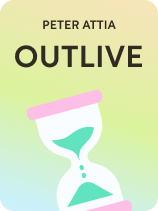
How do you want to spend the last decade of your life? Do you want to be weak, bedridden, and mentally foggy? Or do you want to be busy doing whatever brings you joy?
According to Peter Attia’s Outlive: The Science and Art of Longevity, you can extend the active and fulfilling part of your life by building the right healthy habits. And, the earlier you start building these habits, the better chance you have of circumventing mental and physical decline.
Continue reading for an overview of this book that just might lengthen your life.
Overview of Peter Attia’s Outlive
In our overview of Peter Attia’s Outlive: The Science and Art of Longevity, we’ll begin by detailing the chronic diseases you must avoid to live a long and active life, and we’ll explain what causes these diseases. Then, we’ll describe the actions you can take to avoid these diseases, explaining how best to exercise, what to eat, and a few other miscellaneous health tips.
Attia is a medical doctor and surgeon. He’s the creator of Early Medical, an intensive online course on personal wellness and longevity. He also hosts the podcast The Drive, which features conversations with experts on health, longevity, and performance. Attia wrote Outlive to be a practical guidebook that a general audience can use to improve and lengthen their lives.
To Live Better, Avoid Chronic Disease
According to Attia, the key to avoiding physical and mental decline in old age is preventing four specific chronic diseases: heart disease, cancer, neurodegenerative diseases (like Alzheimer’s and dementia), and type 2 diabetes. By chronic, we mean that these diseases progress throughout a person’s life rather than coming and going quickly, like a cold or flu. As you grow older, your chance of contracting these four diseases increases, and they’re responsible for the vast majority of deaths in the elderly. Even if these diseases don’t kill you, they greatly hinder your physical and mental capabilities, reducing your quality of life.
To avoid these diseases, take early preventative action. Although they often appear to strike suddenly, they don’t present crippling physical and mental symptoms until after they’ve slowly progressed for decades inside your body. Attia contends that by fighting these diseases decades before they present themselves, you’ll often be able to avert them entirely.
Unfortunately, in our current medical system, doctors and hospitals often use a fee-for-service model—this means that doctors get paid for administering expensive treatment, not for prescribing low-cost preventative measures. They neglect to diagnose patients with these chronic diseases until severe symptoms manifest, at which point it’s much more difficult to stall or reverse their progression. For this reason, you can’t just rely on your doctor to keep you healthy—you must take your health into your own hands and proactively work to prevent these chronic diseases.
What Causes Chronic Disease?
How, specifically, can you avoid these four chronic diseases? Attia notes that although these diseases cause your body to break down in totally different ways, there’s an incredibly common yet preventable health condition that directly causes all four: metabolic dysfunction. By keeping your metabolism healthy, you can greatly reduce your risk of contracting all four chronic diseases.
Next, we’ll explain what metabolic dysfunction is and what causes it. Then, we’ll detail how metabolic dysfunction leads to all four chronic diseases.
Defining Metabolic Dysfunction
Attia explains that “metabolism” is the process by which your body converts the food and other nutrients you consume into energy and materials used to build, repair, and maintain your body. However, if you regularly ingest more nutrients than you need—in other words, if you consume too many calories—your body will start storing them in increasingly unhealthy ways.
Your body converts much of the food you eat into glucose (also known as blood sugar), a form of energy that’s easily stored, transported, and utilized. If your body doesn’t need to immediately burn that glucose as energy, it can store it in healthy ways: in your muscles and liver as a compound called glycogen, or as subcutaneous fat, the healthy layer of fat found under your skin all over your body. However, Attia warns that once this storage is full, your body begins storing this energy in places where it doesn’t belong; for instance, unhealthy visceral fat. This is abdominal fat that surrounds important internal organs and causes dangerous inflammation (an immune response that can cause pain, swelling, and other symptoms).
Eventually, after you’ve consumed too many nutrients over an extended time, tiny bits of fat squeeze their way inside muscle cells. Attia explains that this fat weakens your cells’ ability to absorb glucose from the bloodstream and use it as energy. Your pancreas tries to compensate for this damage by increasing production of insulin, the hormone that helps push blood glucose into cells that need it. Unfortunately, if your cells are overloaded with elevated insulin for too long, they become less responsive to insulin and absorb even less glucose—a condition called insulin resistance. Insulin resistance directly causes all four of the chronic diseases we mentioned before.
The term “metabolic dysfunction” refers to this condition as a whole—insulin resistance is one main component of metabolic dysfunction.
How Metabolic Dysfunction Causes Chronic Disease
How could metabolic dysfunction and insulin resistance cause four wildly different chronic diseases? Let’s examine all four.
First, extreme metabolic dysfunction is type 2 diabetes. Attia explains that you qualify for a diagnosis of type 2 diabetes when you reach a certain level of chronically elevated blood sugar and insulin resistance.
Second, metabolic dysfunction directly increases your risk of cardiovascular disease, Attia states. When your metabolism is dysfunctional, your blood pressure increases, damaging the walls of your blood vessels. This damage increases your risk of harmful cardiovascular incidents by causing plaque to build up along your vessel walls. This may eventually clog your blood vessels or force a clot into the bloodstream, causing a heart attack or stroke.
Third, metabolic dysfunction provides the perfect environment for cancer cells to grow. Attia explains that cancer cells consume more glucose than healthy cells do, and they use insulin to absorb these vast amounts of glucose. The more insulin is in your bloodstream, the more fuel is available for cancer cells to grow.
Finally, Attia asserts that metabolic dysfunction causes neurodegeneration: chronic damage to your brain. To function properly, the brain needs a lot of energy—typically in the form of glucose—and it depends in part on insulin to get the glucose it needs. In particular, the parts of the brain responsible for memory appear to be more dependent on insulin than other parts. If you trigger insulin resistance in the brain, the memory systems can’t get the energy they need, and neurodegeneration sets in.
Now that we’ve explored the chronic diseases you need to prevent if you want to age healthily, let’s discuss Attia’s tips on how to prevent them. We’ll begin with his tips on exercising.
How Should I Exercise?
Attia contends that consistent exercise is the number one habit you can practice to improve your health. As we’ll see, it significantly increases your lifespan and helps ward off all the major chronic diseases.
Attia assumes that one main reason you want to avoid disease is so you can keep doing the things that bring you joy. He outlines a set of exercise guidelines intended to help you reach this goal: to maintain enough physical fitness to do everything active you want to do for as long as possible. If you want to continue playing basketball with your friends through your twilight years, or if you just want to be able to walk your dog and tend your garden, Attia recommends regularly practicing three types of exercise: Zone 2 endurance training, VO2 max sprint training, and muscle-centered strength training. Let’s discuss each of these in turn.
Build Endurance Through Zone 2 Training
First, Attia recommends regular “Zone 2” aerobic exercise. Exercise experts describe the intensity of a given exercise using one of five “zones.” Zone 2 is light-to-moderate exercise: pushing yourself just hard enough that it’s slightly uncomfortable to speak.
Zone 2 exercise is beneficial because it causes your cells to produce more high-quality mitochondria—organelles in your cells that metabolize glucose and fatty acids into energy. The more mitochondria you have and the stronger they are, the more fat and glucose they can burn. This frees up storage space for calories you eat that would otherwise cause metabolic dysfunction.
Attia recommends that the average person engage in Zone 2 exercise for at least three hours a week. That said, if you’re recovering from a sedentary lifestyle, Attia notes that two 30-minute sessions per week are enough to drastically reform your health.
Stretch Your Physical Limits Through VO2 Max Training
Second, Attia recommends increasing your VO2 max: the volume of oxygen that your body can effectively transport and utilize to create energy while you’re pushing yourself to your physical limits. This number, more than any other, precisely reflects your overall physical fitness. The higher your VO2 max, the more physical activities you’ll be able to perform and enjoy.
Why do you need a high VO2 max to be physically fit? Attia explains that your cells need oxygen to convert glucose and fats into energy. Exercise increases the demand for oxygen throughout your body, and the more intensely you exercise, the more likely it is that your oxygen demand will exceed your VO2 max. At this point, your cells lose oxygen and must resort to less efficient means of energy generation. You’ll hit your physical limit and won’t be able to complete whatever physical activity you’re trying to do.
VO2 max declines sharply as you age. So, to do all the physical tasks you want to in your elderly years, compensate for this decline by training your VO2 max as much as possible. Attia adds that, aside from enabling an active lifestyle, a high VO2 max will reduce your risk of disease—research shows that VO2 max is strongly correlated with a longer lifespan.
To improve your VO2 max, Attia recommends a high-intensity interval exercise rhythm: Warm up, then perform four-minute spurts of aerobic exercise at the fastest pace you can steadily maintain for those four minutes. Take four minutes of recovery by exercising at a slow, easy pace. Repeat this sprint-rest cycle four to six times, then cool down. Doing this once a week is enough to gradually raise your VO2 max.
Build Muscle Through Strength Training
Finally, Attia recommends building as much muscle as possible. Research shows that, the bigger and stronger your muscles are, the longer you’ll live and the healthier you’ll be.
One reason for this is that the more muscle mass you have, the easier it is to be metabolically healthy. Attia states that muscle tissue is better at metabolizing glucose than other parts of your body, So, the more muscle you have, the easier it is to keep your blood sugar low and stable. Additionally, building muscle increases your capacity to store glucose as glycogen for short-term energy consumption, rather than storing it as potentially harmful fat.
Unfortunately, around the time someone turns 65, they begin losing muscle at an alarming rate. Unless you build up above-average muscle mass before this time, your muscle mass will drop low enough during your elderly years to leave you significantly more vulnerable to chronic disease and injury. Attia recommends regular strength training (specifically, weightlifting) to prevent this as much as possible.
However, Attia emphasizes that, if you perform intense strength training exercises poorly, they can do more harm than good—specifically, if they cause you to badly injure yourself. Train yourself to use the proper form when practicing strength exercises, and use lighter weights until you’ve built up the bodily awareness you need to avoid injury when lifting heavier weights.
What Should I Eat?
In addition to exercising correctly, eating a healthy diet is key to maintaining your physical and mental capabilities in old age. Attia emphasizes that what you should eat depends on your unique body—there’s no diet that’s universally the “healthiest” for everyone. Everyone’s body metabolizes food differently, so the exact same diet might help one person and harm another.
Although there’s no universally optimal diet, Attia offers broad dietary advice that would improve the health of most people. In modern times, many follow what’s called the Standard American Diet, which is heavy in processed, sugary foods. Consequently, they consume too many calories (which contributes to metabolic dysfunction), yet they still don’t get enough of some key nutrients (especially protein).
Attia asserts that most people should do the following:
- Eat more protein
- Eat fewer carbohydrates
- Complete their diet with fats
- Only fast if they have metabolic dysfunction
Finally, as a side note, Attia states that as long as your metabolism is relatively healthy, practicing the ideal exercise routine is more important than consuming the ideal diet. Although fixing your diet is essential if you’re suffering from intense insulin resistance, perfecting your diet yields far fewer health benefits than perfecting your exercise routine.
Most People Should Eat More Protein
According to Attia, most people consume far less protein than their body needs for optimal health. The body uses protein for countless essential tasks, converting it into important enzymes, hormones, and muscle mass. (Building muscle is necessary to increase health and longevity.)
Although US government agencies recommend consuming 0.8 grams of protein per kilogram of body weight a day, Attia asserts that most people need at least double that—1.6 grams per kilogram. If you’re active and trying to gain muscle (as almost everyone should be), Attia recommends 2.2 grams per kilogram (or 1 gram per pound of body weight) of protein.
Whereas excess calories from glucose are sometimes stored in unhealthy ways, your kidneys will filter out any excess protein and you’ll excrete it through urine. Therefore, it’s very difficult to eat too much protein—3.7 grams per kilogram of body weight will strain your kidneys, but the vast majority of people never come close to consuming that much.
Most People Should Eat Fewer Carbs
Most people consume too many carbohydrates, asserts Attia. Although the body uses carbohydrates as its main source of energy, when you consume too many, they raise blood glucose and trigger the overproduction of insulin. This is because your body converts carbohydrates into glucose more readily than any other food group.
That said, Attia notes that carbohydrates in moderation are healthy—and they’re healthier for some people more than others. For instance, although it would be atypical, you may find that cutting carbohydrates out of your diet doesn’t help you burn fat or reduce your blood sugar.
The only way to know for sure how your unique metabolism processes carbohydrates is to experiment with your diet until you’ve found one that helps you reach your health goals.
To help you do this, Attia recommends using a continuous glucose monitor (CGM), an implantable device that allows you to stay aware of your blood sugar levels at all times. Spikes in blood glucose after you’ve eaten something high in carbohydrates indicate times when your body will produce extra insulin in response. By observing what quantities of specific foods cause your glucose (and insulin) to spike, you can learn to avoid or reduce your intake of those foods in the future. Over time, this helps you keep your blood glucose low and avoid insulin resistance.
Complete Your Diet With Fats
When you reduce your consumption of carbohydrates and eat the necessary amount of protein, the rest of your diet will primarily be made of fats. This is perfectly healthy, according to Attia.
Generally speaking, foods high in monounsaturated fats (like olive oil) are healthier than foods high in polyunsaturated fats (like nuts and fish) or foods high in saturated fats (like beef and butter). Attia estimates based on anecdotal evidence that one-third to one-half of people react badly to a diet heavy in saturated fats—it causes them to produce significantly more LDLs and other unhealthy forms of cholesterol, increasing their likelihood of heart disease. That said, for those whose bodies can process it well, saturated fat is perfectly healthy to eat.
Fasting Is Sometimes Good for You (But Usually Bad)
Attia notes that, in recent years, fasting—restricting your calorie intake for fixed periods of time—has become an incredibly popular health trend. But, is it good or bad for you?
Fasting is exactly what some people need. If you find fasting easier than trying to follow strict dietary rules, it can help you reduce your calorie intake to a healthy level. Additionally, within three days of fasting, you’ll trigger starvation ketosis—your body burns fat stores to keep you from feeling hungry, and your cells recycle stray waste materials into functional parts in a process called autophagy.
However, Attia argues that, in many cases, fasting can be detrimental to your health. It’s nearly impossible to eat enough protein to support your body during a fast, so you’re likely to lose muscle (which is very unhealthy). For most people, this is too great of a sacrifice to make. Fast only if you have metabolic dysfunction and desperately need to burn fat to avoid chronic disease.
How Else Can I Stay Healthy?
Alongside exercising and amending your diet, Attia also highlights a couple of other habits that are important to staying healthy: getting enough sleep and taking care of your emotional health.
Get Plenty of High-Quality Sleep
To improve your health and longevity, get more sleep. Attia notes that sufficient sleep gives your brain time to organize its memories, while insufficient sleep results in short-term damage to memory and mental acuity.
Additionally, during sleep, your brain cleans away harmful proteins that accumulate between your neurons during the day. If you don’t give your brain time to do this, these proteins will accumulate and cause long-term damage—including neurodegenerative diseases like Alzheimer’s.
Furthermore, multiple studies suggest that poor sleep disrupts your metabolism, making metabolic dysfunction and chronic disease much more likely. Although researchers aren’t totally sure why this is, Attia theorizes that it’s because insufficient sleep puts your body into perpetual fight-or-flight stress. The stress hormone cortisol raises blood pressure and triggers the liver to release glucose into the blood. This can lead to insulin resistance and an increased risk of chronic disease.
Take Care of Your Emotional Health
Finally, Attia emphasizes the importance of taking care of your emotional health. Attia recounts his lifelong journey to overcome feelings of rage toward others and himself, both of which had roots in his childhood trauma.
Often, children who go through traumatic incidents (big and small) adopt emotional coping strategies that hurt them in later adulthood—like how Attia learned to feel angry at himself and others to avoid dealing with the shame from his childhood trauma. Attia recommends using psychotherapy as a tool to uncover how you’ve adapted to past traumas and to develop a plan to repair your unique emotional dysfunction. Doing so, he argues, is the surest way to achieve an emotionally fulfilling life.

———End of Preview———
Like what you just read? Read the rest of the world's best book summary and analysis of Peter Attia's "Outlive" at Shortform.
Here's what you'll find in our full Outlive summary:
- A guide on how to extend the active and fulfilling part of your life
- How to circumvent the mental and physical decline that often comes with age
- The one chronic condition that can cause four of the most deadly diseases






